Electric Insulator Market Research, 2031
The global electric insulator market size was valued at $12.6 billion in 2021, and electric insulator industry is projected to reach $20.8 billion by 2031, growing at a CAGR of 5.2% from 2022 to 2031.
An electrical insulator is a material in which electric current does not flow freely. The atoms of the insulator have tightly bound electrons which cannot readily move. Electric insulators are mandatory for the distribution of electric. It has become necessary because it ensures safety of both man and machine. There is growth in the demand for electricity is growing rapidly owing due to increase in population and increase in power consumption per capita. The need for stable and reliable supply of electricity is the key to the development of all countries which is a major driving factor.
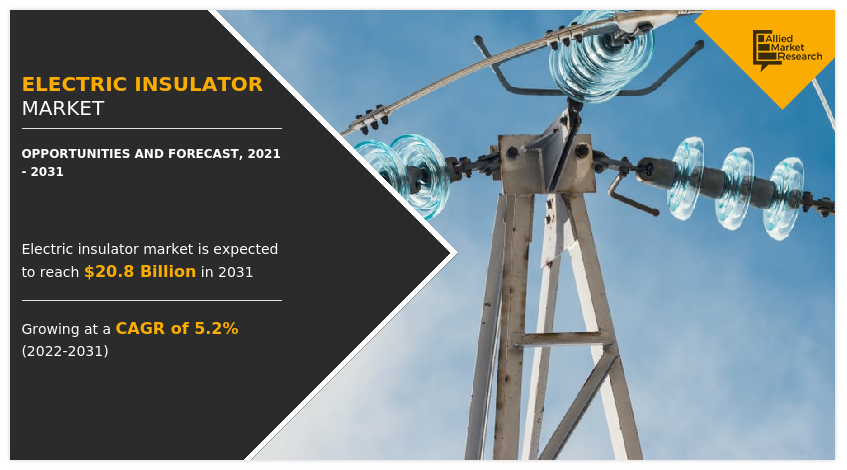
Robust development of high-voltage transmission networks coupled with the ongoing advancements in grid infrastructures are projected to boost the growth of the high voltage electric insulator market. A paradigm shift toward renewable energy generation including the deployment of large wind & solar based projects is anticipated to further fuel the electric insulator market growth. Moreover, favorable government norms, policies, schemes, and rebates toward the installation of sustainable power sources is projected to augment the market growth.
The government of the U.S has taken the initiative to modernize, upgrade, and refurbish aging electrical infrastructure. Similar efforts are made in Europe, China, Australia, and Canada. Such actions are expected to boost the demand for electrical insulator market. The introduction of long distance high voltage transmission all over the world has augmented the need for electrical insulators. Electrification in developing countries of South America, Asia-Pacific, Middle-East, and Africa is expected to surge the demand for electric insulators. Furthermore, the emergence of renewable power generation projects in the above mentioned developing countries has increased the need for electric insulators.
The electric insulator market forecast is segmented on the basis of type, material type, voltage, application, end use and region. On the basis of type, the market is segmented into shackle insulator, pin insulator, suspension insulator, and others. On the basis of material type the market is segmented into ceramic, composite, glass, and others. On the basis of voltage, it is bifurcated into low, medium and high. On the basis of application, it is segmented into transformer, cables, switchgear, busbar, surge protection devices, and others. In addition, on the basis of end use, the market is segmented into utilities, Industries and others.
Region wise, the market is studied across North America, Europe, Asia-Pacific, and LAMEA. Presently, Asia-Pacific accounts for the largest electric insulator market share, followed by North America and Europe.
The major companies profiled in this report include ABB, Siemens Energy, GE Grid Solutions, Hubbell Power Systems, NGK Insulators, Ltd., Aditya Birla Insulators, MacLean-Fogg Company, Elsewedy Electric, Seves Group, BHEL, TE Connectivity, Modern Insulators, Almatis GmbH, Hitachi Energy, Olectra Greentech, Zhengzhou Orient Power, and INCAP.
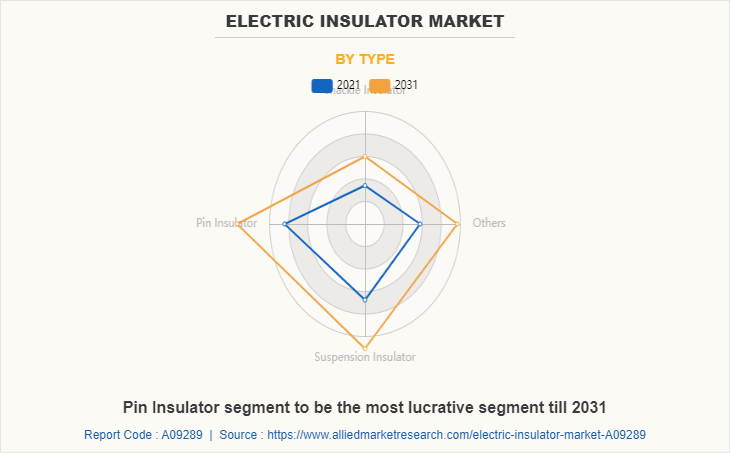
The pin insulator segment dominates the global electric Insulator market. The pin insulators segment is expected to attain a CAGR of 4.8% through 2031. This insulator is generally used in 33kV power distribution systems and is made up of glass. They are used in applications across sub-transmission & distribution lines including single- & multi piece as conditioning on the voltage applications. The product offers key advantages including availability of multi-piece construction, high reliability, and ease of installation, stimulating the industry value. This is expected increase its adoption and thus, drives the market growth during the forecast period.
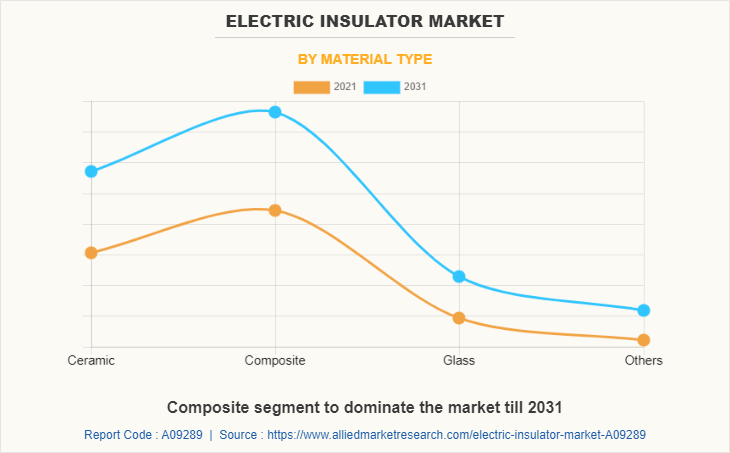
The composite segment dominates the global electric Insulator market. The composite material insulator segment is expected to attain CAGR of 4.8% through 2031. Rise in investments in repairing out-dated grid networks across industrialized countries and the growing adoption of smart grid technologies will increase the demand for composite insulators. The increased emphasis on grid network expansion, advantages of composite insulators, and substantial expenditures by regulatory authorities in the construction of efficient electric infrastructure will boost the demand for composite insulators. Furthermore, favorable power distribution changes and increased industrialization and commercialization will drive the demand for composite insulator in electric insulator market. This is expected increase its adoption and thus, drives the market growth during the forecast period.
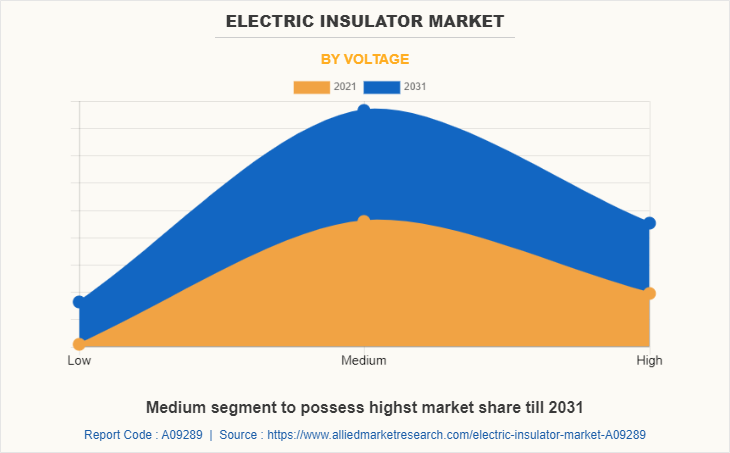
The medium voltage segment dominates the global electric Insulator market. The function of medium voltage insulators is to isolate the charged parts with different potential in electrical equipment. Therefore, insulating materials should first have high insulation resistance and voltage strength, and can avoid leakage, breakdown and other accidents. Secondly, it has good heat resistance and avoids aging and deterioration due to long-term overheating. In addition, it should have good thermal conductivity, moisture and lightning resistance, high mechanical strength and convenient processing. This range of voltage insulator is designed for switchgear application to offer various range of testing equipment starting with electric serial test, x ray testing, gas leakage testing in regards with consumer specific. The presence of above mentioned advantages will drive the growth of the market.
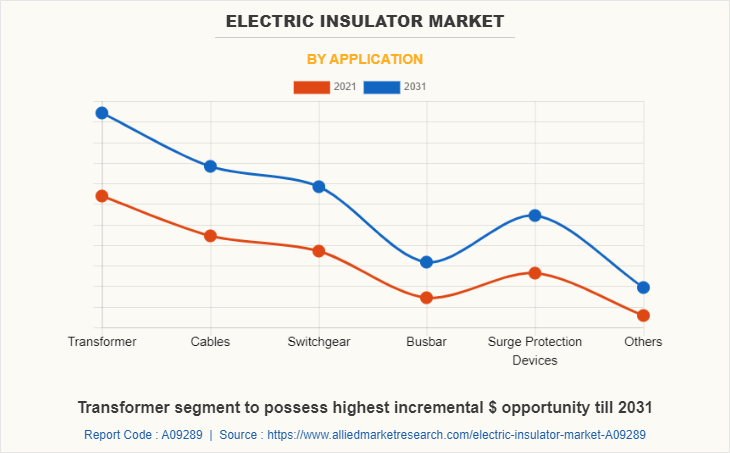
The transformer segment dominates the global electric Insulator market. The transformer application is started to witness noteworthy growth due to the government national renewable targets and the replacement of conventional electrical networks. The utilities have been majorly focusing on grid upgrades and expansion to sustain the growing renewable mix. Favorable policies including incentives, leveraging schemes, feed-in tariffs, and subsidies to promote the deployment of clean energy sources, will in turn further escalate market growth. The presence of above mentioned wide range of utilization of electric Insulator in transformer for power transmission applications will provide ample opportunities for the market.
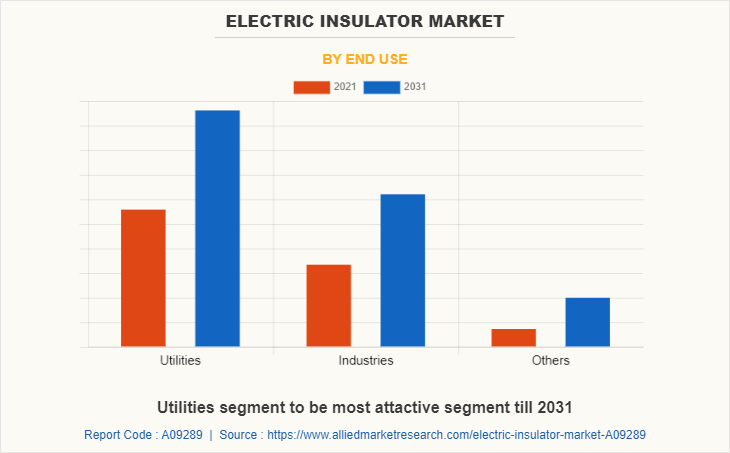
The utilities segment dominates the global electric Insulator market. The electric insulator market across utilities is estimated to grow on account of increasing investments & expenditures for the expansion of utility infrastructures and transmission networks across remote locations. Upsurge in research & development activities toward modernizing the grid structure to meet the increased electricity demand will boost the industry progression. Furthermore, the integration of smart grid technologies favored by numerous rollout schemes will augment the market trends. The presence of above mentioned application of electric insulator in power generation and transmission utilities will provide ample opportunities for the market.
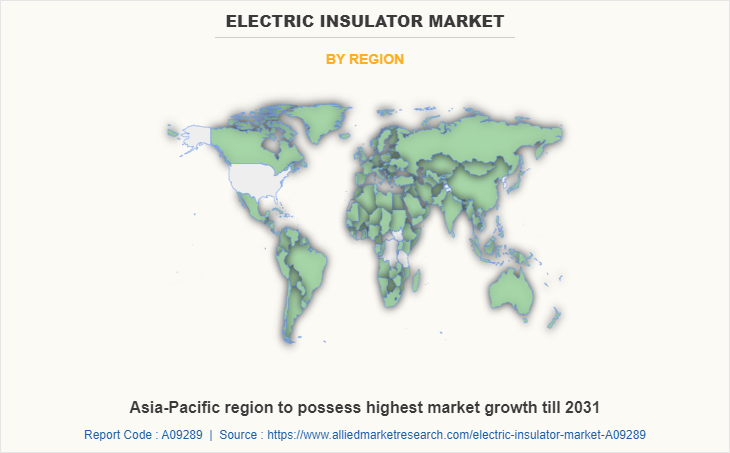
Asia-Pacific dominated the growth of the electric insulator market during the forecast period. Asia-Pacific is made up of many developing and under-developed countries, and is also the most populated region across the globe. It is also a home to a significant number of megacities and with the ever-increasing population. China and India are the major revenue contributors in the region. Growth of population increases the demand for electricity which correspondingly drives the demand for passive electronic components such as insulators. Growing trend of smart cities and smart grids is expected to surge the market in coming years. With the rise in urbanization and the emergence of advanced technologies, many countries are focusing on building smart cities for a healthier and luxurious lifestyle. Furthermore, the development of Woven city by the Toyota and the investment of Indian government in more than 100 smart cities will provide ample opportunities for the development of the market. The above mentioned initiatives are major factor driving the growth of the market in this region during the forecast period.
COVID-19 analysis:
COVID-19 has severely impacted the global economy with devastating effects on global trade, which has simultaneously affected households, business, financial institution, industrial establishments and infrastructure companies. The novel coronavirus has affected several economies ad caused lockdown in many countries which has limited the growth of the market. The shutdown of industrial manufacturer led to the decline in the demand for solar related equipment in most of the countries across the world led to decline in the demand of the electric Insulator market. The decrease in utilization of power in the industrial facilities across the globe during the outbreak has a negative impact on the development of the market.
Key Benefits For Stakeholders
- This report provides a quantitative analysis of the market segments, current trends, estimations, and dynamics of the electric insulator market analysis from 2021 to 2031 to identify the prevailing electric insulator market opportunities.
- The market research is offered along with information related to key drivers, restraints, and opportunities.
- Porter's five forces analysis highlights the potency of buyers and suppliers to enable stakeholders make profit-oriented business decisions and strengthen their supplier-buyer network.
- In-depth analysis of the electric insulator market segmentation assists to determine the prevailing market opportunities.
- Major countries in each region are mapped according to their revenue contribution to the global market.
- Market player positioning facilitates benchmarking and provides a clear understanding of the present position of the market players.
- The report includes the analysis of the regional as well as global electric insulator market trends, key players, market segments, application areas, and market growth strategies.
Electric Insulator Market Report Highlights
| Aspects | Details |
| By Type |
|
| By Material Type |
|
| By Voltage |
|
| By Application |
|
| By End Use |
|
| By Region |
|
| Key Market Players | Seves Group, Modern Insulators, Siemens AG, MacLean-Fogg Company, NGK Insulators, Ltd., TE Connectivity, Elsewedy Electric, Hitachi Energy, Hubbell Power Systems, BHEL, Almatis GmbH, Aditya Birla Insulators, Olectra Greentech, Zhengzhou Orient Power, GE Grid Solutions, INCAP, ABB Ltd |
Analyst Review
According to CXO perspective, the global electric insulator market is expected to witness increased demand during the forecast period, due to rapidly growing functionality, convergence & complexity of electronic devices coupled with rise in demand for smart components from emerging markets is expected to drive the electric insulator market growth.
Electric insulators can prevent electric current from flowing in the wrong direction. As a result, they have found their use in coating wires and as dielectrics in capacitors. Electric insulators have been used to offer protection against the harmful effects of electricity, which has made them suitable for use in electricity transmission and distribution networks.
Rapid urbanization in developing economies has led to the development of new buildings, which has helped fuel the demand for electric insulators and propels the overall electric insulator market. Rising demand for refurbishment of dilapidated buildings, particularly in developing economies, and increasing adoption of smart grid technology are the key growth drivers for the overall electric insulator market. The increasing demand for automation in other diverse industry verticals such as automotive, IT and Telecom, energy and power, and others is expected to offer ample growth opportunities for market players.
Development of smart grids and surge in development of micro grid networks across developing countries are the key factors boosting the Electric insulator market growth.
Transformer segment is projected to increase the demand for Electric insulator Market
ABB, Siemens Energy, GE Grid Solutions, Hubbell Power Systems, NGK Insulators, Ltd., Aditya Birla Insulators, MacLean-Fogg Company, Elsewedy Electric, Seves Group, BHEL, TE Connectivity, Modern Insulators, Almatis GmbH, Hitachi Energy, Olectra Greentech, Zhengzhou Orient Power, and INCAP
The market value of Electric insulator in 2031 is expected to be $20.8 billion
The global electric Insulator market is segmented on the basis of by type, by material type, by voltage, by application, by end use and region. On the basis of type, the market is segmented into shackle insulator, pin insulator, suspension insulator, and others. By material type the market is segmented into ceramic, composite, glass, and others. On the basis of voltage, it is bifurcated into low, medium and high. On the basis of application, it is segmented into transformer, cables, switchgear, busbar, surge protection devices, and others. In addition, on the basis of end use, the market is segmented into utilities, Industries and others. Region wise, the market is studied across North America, Europe, Asia-Pacific, and LAMEA.
Increase in renewable energy market is the Main Driver of Electric insulator Market.
The presence of lockdown restrictions imposed by various governments globally affected the end-user demand, as electric construction projects halted during the pandemic outbreak. However, rapid integration of renewables and distributed technologies onto the grid, utilities are upgrading at the already aging infrastructure. The development of renewable based power generation is expected to result in expansion of power transmission infrastructure, resulting in increase in the demand for electric insulators post pandemic.
Loading Table Of Content...



